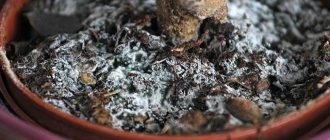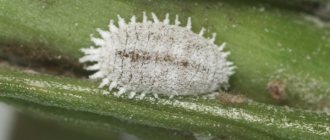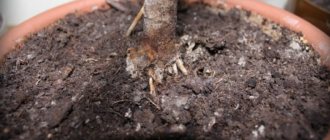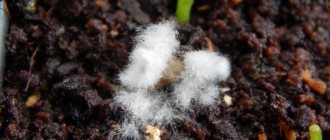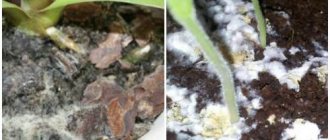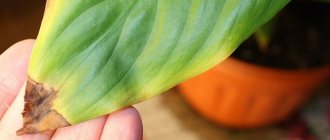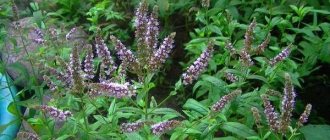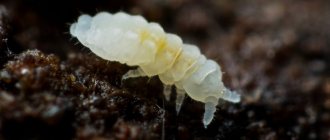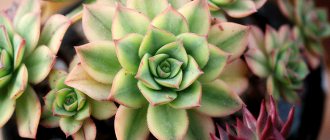When growing indoor plants - flowers, ornamental trees, exotic fruits - sometimes white spots appear on the surface of the soil or on the pots themselves. They can be barely noticeable or cover the soil with a dense cover.
It is necessary to understand the reason for the appearance of white plaque and determine methods to eliminate the problem.
- 5.1 Folk remedies
Reasons for the appearance of white plaque on the ground in flower pots
There may be several reasons why the soil in a pot becomes covered with a white coating. It should immediately be noted that failure to follow the rules of care, especially watering, is a source of problems with the well-being and appearance of indoor plants.
Among the most common reasons why the soil is covered with a white film are the following.
- Incorrect watering, as mentioned above. Alternating drying out and excessive moisture, or frequent watering with a meager amount of water, in which only the top layer of soil becomes wet, and the roots remain dry.
- Too high or low humidity , especially in combination with fluctuations in room temperature.
- Unsuitable container for the plant. In a pot that is too small, as well as in a pot that is too large, the root system does not develop properly and cannot absorb the required amount of nutrients and minerals.
- Stagnation of water in a pot (due to lack of drainage) or in a tray can also cause white deposits to appear.
Why do animals eat and dig?
Usually, young Alabai puppies and kittens, who are just exploring a new world and trying to taste everything, dig or eat soil, grass, and coal. How to wean a puppy or child if he climbs and scoops up the soil? The animals are driven by ordinary curiosity, so after several attempts to eat the earth, everything stops. The toy terrier puppy will understand that the soil is not tasty and will not try it anymore. However, this sign is not curiosity, but the cause of the psychological state of the dog or cat. This happens because the animal does not feel comfortable in the house or has a dislike for the new family member.
Perhaps the owner treats the cat or dog poorly, punishes him, and he takes revenge in this way. Sometimes animals chew and tear furniture, walls or shoes of their owner. Therefore, in order to understand why an animal licks clay and sand, digs or eats soil from a flower pot, it is necessary to examine its health, for example, for feline anemia. If the reasons lie in the animal’s personal hostility or psychological discomfort, then the owner and his household should give the pet more affection. It is very important to communicate more with your pet, spend time with him, praise him, and play with the animal.
Types of deposits on the ground
Most often, white plaque on the ground in flower pots is:
- efflorescence on the ground;
- fungal diseases.
A thin layer of salt forms on the soil surface if there is an excess of minerals:
- in a large pot, the root system simply does not have time to “take” all the microelements from the ground, they appear on the surface with water;
- in case of an excess of microelements: for example, the soil for seedlings is additionally enriched with nutritional and chemical compounds. If you plant an adult plant in such soil that does not need such intensive feeding, the excess minerals will appear in the form of salts on the ground.
- if you get carried away with applying fertilizers, especially potassium ones, they are not absorbed by the plant and produce a salt deposit.
Fungal infections with a white coating:
- powdery mildew;
- mold fungus mucor;
- blue;
- black mold;
- actinomycetes are soil inhabitants that are both fungi and bacteria.
Fungal infection
In this case, the white color of the plaque is given by spores - microscopic “seeds” of fungi. Spores are easily carried by the wind, and can also be carried on the hands of the grower from other infected plants.
Very rarely, at home, a white coating on the soil can be caused by an invasion of aphids, which secrete a sticky substance - honeydew.
Pests, insects and diseases
Very often, pests lay their larvae in the soil, where they remain for a long time. If this problem is not dealt with, the number of harmful larvae in the soil will only increase. And some conditions can contribute to this, for example, heating the soil in the cold season, etc.
Ventilation diagram in a greenhouse.
The most common pests include:
- wireworms,
- cabbage flies,
- mole cricket,
- spider mite and others.
Other types of soil diseases include infections of vegetable crops - these are various mold spores and fungal diseases that can also penetrate the soil and cause its contamination. Many microorganisms are able to penetrate not only into the soil, but also constantly remain on the frame of the greenhouse itself (especially if it is made of wood). Therefore, if you carry out measures to disinfect the soil, it is necessary to touch all parts of the greenhouse in order to completely prevent the re-production of harmful microorganisms.
Common soil diseases:
- clubroot;
- late blight;
- spots on leaves;
- macrosporiosis;
- peronosporosis.
How to treat?
What to do to combat white plaque on the ground in pots will depend entirely on the cause of the whitening of the ground. Below we discuss options for getting rid of soil salinity.
Mulching with expanded clay
If you find white soil in flower pots, the top layer of soil should be removed and replaced with a layer of fine expanded clay. In addition to the mulching effect (to slow down the evaporation of moisture), it will also serve as a decorative design for the plant. Decorative pebbles, disinfected bark, and coarse quartz sand are also suitable for these purposes.
Soil waterlogging
When air humidity is more than 80% and constant high temperature (more than 25 ° C), the soil in indoor flowers can also turn white from the appearance of crystals of mineral salts. Accordingly, when these parameters are lowered, the problem disappears by itself.
Oversaturation with fertilizers
If there is an excess of mineral fertilizers in the soil for indoor plants, as mentioned above, they are not completely absorbed by the plant; some of them crystallize on the surface. The solution to the problem is to stop feeding. For an aesthetic effect, the top layer of soil from the pot can be removed and replaced with fresh one.
Oversaturation with fertilizers
What to do and how to get rid of it
If mineral deposits appear on the surface of the soil, most likely you are not watering your plant correctly.
The plaque may be yellow or white. One of the reasons: we water the plant with poor tap water. Due to high hardness, lime deposits appear.
How to deal with it:
- Stop watering the flower with tap water. Water is collected into a container for irrigation and left for a day.
- Citric acid is added to the water. Dosage: 0.5 teaspoon per 1 liter.
Interesting! Instead of lemongrass, dilute a store-bought softener.
Mold Control Products
Regardless of the type of harmful fungus that has settled in the pots, the principles of control will be the same.
Folk remedies
The means at hand will help get rid of the white coating on the soil at the early stage of mold infection, when the mycelium has not yet had time to grow into the deeper layers.
- Garlic has excellent fungicidal and disinfectant properties. You can dig a few peeled cloves into the soil or water the ground with infusion (pour 3 crushed cloves with a glass of boiling water, leave for a day).
- For plants that prefer acidic soils , watering with a solution of citric acid (no more than 3 g per 200 ml of water) can be recommended. This treatment should be carried out no more than 1-2 times a month.
- Ash, on the contrary, alkalizes the soil, improves its structure and oxygen saturation. Depending on the size of the pot, 1-5 tbsp. l. ash is added at the root and gently mixed with the top layer of soil.
Purchased funds
If the soil in flower pots turns white due to the development of pathogenic mold fungi, then changing the soil is no longer possible; folk remedies are not always effective. You will have to resort to the help of fungicidal drugs, which suppress the growth of microflora.
To get rid of mold in flower pots, the following chemical fungicidal preparations can be recommended.
- Azofoska is a domestic drug, an active ammonium-copper-phosphate compound. The working solution is prepared according to the instructions and sprayed on the plant and soil. The composition is also a foliar fertilizer for plants, providing the required amount of nitrogen compounds, copper, calcium, phosphorus, etc.
- Topsin M is a systemic fungicide, jointly developed by Japanese and German chemists. The active toxin is methyl thiophanate. Used for spraying and watering the soil under the plant.
- Sarfun 500 SC is a product manufactured in Poland. The active substance is carbendazim. Systemic highly effective fungicide, used for spraying, compatible with almost all chemicals.
Advice! To be sure to get rid of white mold deposits on the soil, carefully read the instructions for the drug, which describe how to prepare and use it (concentration, frequency of treatments, precautions, etc.).
Azofoska
Fungal infection
Sometimes plaque in a pot appears due to a fungus that has settled in the soil. The plaque in this case is more like whitish fluff or mold, and the smell of rot will emanate from the ground. Most often, the appearance of fungus is caused by excessive soil moisture or keeping the flower in unsuitable conditions.
Suitable conditions for the growth of the fungus are air humidity reaching 85-90% and a warm temperature of +20-25 degrees. Stagnant, unventilated air and a minimal amount of sunlight also contribute to the appearance of mold and fungus in flower pots. Note that the fungus is destructive to the plant: if measures are not taken in time, the flower may die.
Urgent and radical measures need to be taken: simply replacing the top layer of soil will not get rid of this. It is necessary to remove the flower from the pot, wash its roots, treat it with a disinfectant, then replant it in a new container with fresh soil. The old soil is thrown away, and the pot in which the plant was located must be thoroughly rinsed and disinfected.
But if fungus or mold has grown in a plastic pot, it is better to throw it away: fungal spores are very difficult to remove completely in this case. Ceramics and clay can be disinfected.
Tip: Treat the soil with an antifungal fungicide to prevent the development of fungus.
Prevention
To prevent the appearance of white plaque in flower pots, you should adhere to simple rules of home gardening.
- It is necessary to ensure drainage in pots (plant pots). To do this, expanded clay, pebbles, and fine gravel are poured onto the bottom (about a quarter of the height of the container with the plant). Drainage is necessary to remove excess moisture from the roots.
- Optimal watering. It is necessary to water indoor plants when the soil dries to a depth of 3 cm. Wait until water begins to come out of the drainage holes. Sometimes, instead of watering, you can use spraying or deep loosening of the soil.
Advice! It is better to dry out the soil in the pot than to over-water it!
- The composition of the soil must be balanced for a particular plant. In general, we can say that indoor flowers love loose, low-fat substrates, so adding sand, vermiculite, etc. to the soil mixture will not be superfluous.
- You should not get too carried away with mineral fertilizing, especially in the winter season , when the growth and development of the plant slows down and it requires less nutrients.
- To normalize the soil microflora , you can periodically (1-2 times a month) water it with a weak solution of potassium permanganate and/or water acidified with citric acid or lemon juice.
- Ultraviolet light is a panacea for many diseases. Regular sunbathing will help make the plant strong and immune to various ailments.
Soil waterlogging
Simple solutions for soil care.
If the soil is waterlogged, then in the near future you may find algae, fungus and mosses in your beds. This is also facilitated by warm air in the greenhouse. Particular insidiousness may come from groundwater, which may be located in the area of the greenhouse. Often, the owner of a greenhouse may not be aware of this and water his plants as usual, resulting in excessive moisture, which in turn leads to soreness and greening of the soil.
How to distinguish moss from algae? These two species can often be confused, but they have distinctive features:
- When the greenhouse lighting is poor, moss appears on the plants and soil.
- But if there is enough light in the greenhouse, then we can talk about the formation of algae.
Increased soil acidity
To reduce the acidity of the soil, which causes moss and mold to spread throughout the area (and this is detrimental to plants), you need to take the following actions:
- Add tree resin to the soil; this should be done from time to time. But not too often.
- Add lime to the soil.
- Dolomite flour added to the soil effectively eliminates soil diseases.
Norms for soil acidity levels.
It is advisable to add these fertilizers to the soil at the time of digging up the earth, before planting and after harvesting. In this case, the soil in the greenhouse will not deoxidize, causing mosses to stop appearing.
To ensure that plants grow well in the soil and produce a harvest, do the following:
- Sprinkle lime on the soil and do not dig up the soil.
- After this, sow green manure - this is a fast-growing grass.
- After the grass sprouts, plant seedlings of other vegetable crops in the soil.
- After the seedlings have taken root, the grass is mowed and subsequently used as mulching material.
Correct crop rotation in the greenhouse
In order for plants to grow well in a greenhouse, proper crop rotation must be observed. To do this, you need to know which plants like well-fertilized soil and which less fertilized ones.
Therefore, plants are divided into the following groups:
- Plants with low fertilizer consumption.
- With average fertilizer consumption.
- With high fertilizer consumption.
It is necessary to be able to alternate planting of such plants. For example, tomatoes consume a lot of fertilizers, and after harvesting, other plants with the least fertilizer consumption can be planted in this place.
Some tips for proper crop rotation.
Do not grow one variety of vegetables in the same place for years, alternate crops, this will avoid soil fatigue.
Select suitable neighbors from vegetable crops. For example, tomatoes and sweet peppers coexist in one garden bed. And basil planted nearby will also improve the taste of tomatoes, at least that’s what avid gardeners say. But it’s best to plant dill next to cucumbers.
There are plants that can repel parasites. For example, calendula and marigolds repel aphids and nematodes. And nasturtium whiteflies and aphids. To avoid soil diseases, use only high-quality planting material and fertilizers.
At the end of the season, do not neglect cleaning the planting material and cleaning the greenhouse. Remember that in a polycarbonate greenhouse, plants grow better and the soil suffers less.
